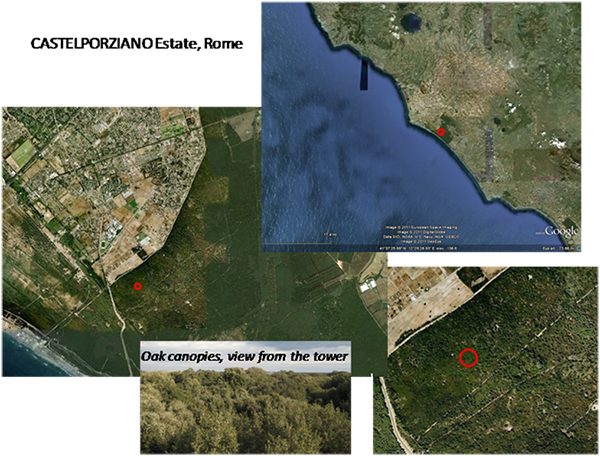Tour
7 April 2017
The Field Tour will be realised through the Urban and Periurban parks of Rome. In particular we will visit two unique examples as Villa Borghese inside the city of Rome and the Castelporziano Estate just in the surrounding area. Crossing Rome by bus you will also have the opportunity to see some of the most famous monuments and attractions of Rome. For instance a brief stop in front of the Colosseum will be carried out. Light lunch will be offered in Castelporziano by URBANFOR3
Villa Borghese
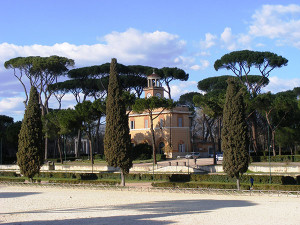 Villa Borghese is one of the largest and the most popular public parks in Rome. It covers an area of about 108 ha nearby Piazza del Popolo in the city centre of Rome.
Villa Borghese is one of the largest and the most popular public parks in Rome. It covers an area of about 108 ha nearby Piazza del Popolo in the city centre of Rome.
The name derives from the first residence of the Cardinal Scipione Borghese built at the beginning of the 17th century and converted into a museum in 20th century. Some of the most prestigious works of art from the 16th to the 18th centuries are collected there, including masterpieces by artists such as Raffaello, Tiziano, Caravaggio, Bernini and Canova.
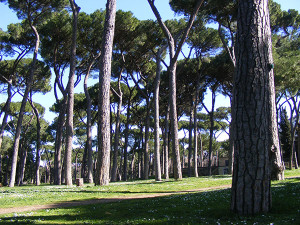 Many historic buildings both from 17th and 19th century can be found within the boundaries of Villa Borghese as well as formal gardens such as the Secret gardens of the Meridiana and the large Lake Garden, redesigned and built in 1786 by the architect Antonio Asprucci and now accessible by boat. Facilities for leisure, recreation grounds and a zoo are included in the area and contribute to make this Park one of the most visited places in Rome by both citizens and tourists.
Many historic buildings both from 17th and 19th century can be found within the boundaries of Villa Borghese as well as formal gardens such as the Secret gardens of the Meridiana and the large Lake Garden, redesigned and built in 1786 by the architect Antonio Asprucci and now accessible by boat. Facilities for leisure, recreation grounds and a zoo are included in the area and contribute to make this Park one of the most visited places in Rome by both citizens and tourists.
Villa Borghese is a relevant green area of Rome marked by the significant presence of the Italian Stone pine (Pinus pinea L.), covering about 28 ha. This tree species is considered a landmark of the Rome’s landscape. Some specimens of Pinus pinea that can be observed in Villa Borghese are particularly impressive, such as some bicentennial monumental trees with stem diameters higher than 100 cm. The Park of Villa Borghese also includes a large number of tree species: holm oaks (Quercus ilex L.), big plane trees (Platanus spp.) – some of them dating back to first establishment – cedars (Cedrus spp.) and other exotic species.
Links
http://www.turismoroma.it/cosa-fare/villa-borghese?lang=en
http://www.sovraintendenzaroma.it/i_luoghi/ville_e_parchi_storici/ville_dei_nobili/villa_borghese (in Italian)
Castelporziano Estate
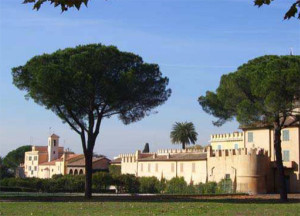 The Presidential Estate of Castelporziano covers an area of about 6000 ha located 25 km SW from the center of Rome, Italy. The Estate is mainly covered by forests representing the last remaining coastal vegetation strip of Lazio. This is a Mediterranean ecosystem whose high ecological value has been noted at an international level (UNESCO) and in 1999 the Estate was recognised as Natural Reserve of the State by the President of the Republic.
The Presidential Estate of Castelporziano covers an area of about 6000 ha located 25 km SW from the center of Rome, Italy. The Estate is mainly covered by forests representing the last remaining coastal vegetation strip of Lazio. This is a Mediterranean ecosystem whose high ecological value has been noted at an international level (UNESCO) and in 1999 the Estate was recognised as Natural Reserve of the State by the President of the Republic.
Castelporziano is an ecosystem having high naturalistic and environmental value due to the habitat biodiversity and richness of species. Thanks to the restrictions in the public access a number of Mediterranean ecosystem types has been preserved (e.g. maquis and pseudosteppe). Soil morphology is mainly flat with sandy materials, but the northern part is formed from volcanic and alluvial materials. In the Tyrrhenian coast the average minimum air temperature of the coldest months (January and February) is 4 °C and the average maximum air temperature of the hottest month (August) is 30°C. Total annual rainfall is 714 mm. The vegetation is typically Mediterranean bushes along the seacoast. Areas with reforestation of pines, as well as corkwoods, pastures, and small agricultural fields are also present. In particular, monumental pinewoods in Castelporziano are composed by even and homogeneous stands whose age ranges from 73 to 142 years-old. Inside Castelporziano, there are two Sites of Community Interest (SIC): the coastal strip (IT6030027) and the hygrophilous oak wood (IT6030028). Wet areas called ‘pools’ are small closed basins with typical vegetation of marshes and surrounded by high forest species. Dunes of Castelporziano represent one of the few examples of undisturbed areas along the coasts of Lazio. From the beach to the inland, five major geomorphological or dune types (facies) have been distinguished: the strandline (high beach), the embryo-dune, the mobile dune (or white dune), the transition dune (or semi-fixed dune) and the fixed dune (grey dune and macchia). The forest surface of Castelporziano belongs to two large zonal biomes of the southern Europe: Holm oak forest and mixed deciduous oak forest. This last one is attributable to the Quercion frainetto alliance, where Turkey oak and Hungarian oak are the most important species of the dominant tree layer, while the Downey oak grows in the driest areas. 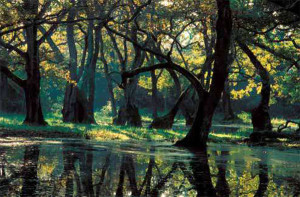 The forest ecosystems dominated by Quercus ilex L. are the typical elements that characterise the coastal areas of the Mediterranean basin, although at present the combined action of factors related to changes in land use and effect of fires resulted in the gradual transformation and fragmentation of primary forests. The forest structure is characterised by two layers: a dominant layer of holm oak trees, 13-16 m high, and a shrub layer of Mediterranean maquis. Several studies concerning carbon flux measurements have proved that the Q. ilex stand is a significant carbon sink, with an annual average of more that -550 gC m-2 year-1, equivalent to 5.5 tons of carbon absorbed by each hectare of the holm oak stand.
The forest ecosystems dominated by Quercus ilex L. are the typical elements that characterise the coastal areas of the Mediterranean basin, although at present the combined action of factors related to changes in land use and effect of fires resulted in the gradual transformation and fragmentation of primary forests. The forest structure is characterised by two layers: a dominant layer of holm oak trees, 13-16 m high, and a shrub layer of Mediterranean maquis. Several studies concerning carbon flux measurements have proved that the Q. ilex stand is a significant carbon sink, with an annual average of more that -550 gC m-2 year-1, equivalent to 5.5 tons of carbon absorbed by each hectare of the holm oak stand.
Since two decades, this area has been a crucial study site to better understand the complex interactions between plants and the urban environment. An experimental tower 20 m tall is located inside a Holm oak forest. Since 2012, the eddy covariance technique has been used to measure fluxes of carbon dioxide, water, ozone, and methane at the ecosystem level. The tower also hosts sensors which measure all ancillary data such as temperature and humidity of the soil and the air, solar radiation and PAR, sap flow sensors installed on stem and braches. All these additional sensors deliver data at 30-min time resolution for all year. Intensive field campaigns are often organised to study bi-directional fluxes of Volatile Organic Compounds (VOC), NOx and their oxidation products formed under photochemical reactions occurring in the polluted atmosphere. Since 1996, the laboratory of Biometeorology at CREA (Council of Agricultural Research and Economics) supervises five complete meteorological stations located in key forest ecosystems inside the Estate. These important data collected inside the Estate support analysis of climate dynamics in the coastal area of central Italy. Data are also used to calibrate models to estimate the ecosystem services provided by a typical Mediterranean periurban forest. The site of Castelporziano has been recently proposed as an ICOS (integrated carbon observation system) level 1 station as a joint effort between CREA, and the National Research Council of Italy. ICOS is a pan-european research infrastructure which provides harmonised and high precision scientific data on carbon cycle and greenhouse gas budget and perturbations.
For further info please click here
In collaboration with


